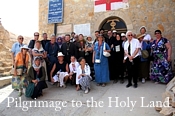1890–1924. ORTHODOX COMMUNITIES IN CANADA
In 1890s: A large number of Galicians, Bukovinians and Carpatho-Russians from their homelands lying within the Austro-Hungarian Empire immigrated to America. Many of them eventually settled in Canada, particularly in the Western provinces, where large areas of land were still available for farming.
Bishop Nicholas (Ziorov) of Alaska and the Aleutian Islands, the ruling bishop of the Russian Orthodox mission in North America with his see in San Francisco, received since 1894 persistent requests for clergy from the Orthodox faithful in Canada’s Western provinces. He organized missionary tours in the diocese with priests from elsewhere.
On June 12, 1897 archpriest Dimitry Kamnev from Seattle and his deacon Vladimir Alexandrov celebrated the first Divine Liturgy on Canadian soil at the village of Stary Wostok near Edmonton in Alberta.
During his visit to Alberta in 1897 Fr. Dimitry Kamnev converted to Orthodoxy the entire population of Stary Wostok – some 600 Galician Uniats. In the same year, Bishop Nicholas (Ziorov) became the first Orthodox Hierarch to visit Canada.
By 1900, priests from Minneapolis (the USA) were able to make pastoral visits to parishes in Manitoba and Assiniboia (Saskatchewan) on a regular basis. On September 1, 1900 Canada’s first permanent priest was appointed: Fr. Jacob Korchinsky set up the St. Barbara mission in Edmonton and worked at building up the body of Christ in Alberta.
In 1901, Bishop Tikhon (Bellavin) of the Aleutian Islands and North America consecrated three churches in Canada.
In 1903, Bishop Tikhon (Bellavin) registered the Orthodox Church in Alberta, Saskatchewan and the Northwest Territories.
In 1906, there were 18 parishes and three priests in Canada under the omophorion of the Russian Church – almost all the Orthodox in Canada. Immigrants from Russia appeared in Vancouver.
In 1907, the parish of Sts Peter and Paul was founded in Montreal by Archbishop Platon (Rozhdestvensky) and Fr. Theophan Byketov. Later that year, Archbishop Platon (Rozhdestvensky) took over the duties of Archbishop of North America, with the see now in New York.
In 1906-1909, in the aftermath of the First Russian Revolution, a number of Russian political activists, fleeing the Tsar’s reprisals, settled in Vancouver. A social and political club existed in 1909-1918.
In 1914, with the beginning of hostilities in Europe, the call goes out across the country for volunteers in the military service. More than 2,000 Russian Canadians signed up. Fr. John Ovsyanitsky served as chaplain to the battalion formed from these volunteers.
In 1916, Canada was established as a separate bishopric (Vikariatstvo) within the North American archdiocese. Bishop Alexander (Nemolovsky), the Vicar Bishop of Alaska, responsible for overseeing Canadian affairs since 1913, was transferred to Holy Trinity Cathedral in Winnipeg, thus becoming the first resident bishop of the Orthodox Church in Canada. He begian to convene councils of clergy and laity. The Parish of Christ the Savior was founded in Toronto in 1916.
In 1917, after the downfall of the Tsar, All-Russian Church Council was convened in Moscow. Archbishop Evdokim (Meschersky) was summoned to participate in the All-Russian Local Council. This Council began at the time of the October Bolshevik Revolution of 1917, and it continued meeting until 1918. At the same time, in the wake of the revolution, the Russian Civil War began (and lasted until 1923). This situation consumed the Russian Church’s attention, and it became impossible for Archbishop Evdokim to return to North America.
Archbishop Evdokim (Meschersky) appointed Bishop Alexander (Nemolovsky) to administer the archdiocese in his absence. Archimandrite Adam (Philipovsky) was left in charge of the affairs of the Canadian bishopric. Canada was left without a bishop for ten years.
The Bolshevik seizure of power was a major disaster for the Orthodox Church in North America, from which it never fully recovered. Suddenly there were no more clergy or funds coming from Russia, which resulted in hardship and calamitous disorganization.
In 1918, the disintegration of the Archdiocese into separate ethnic jurisdictions began. It had 64 parishes and 47 clergy in Canada, including two Serbian, one Bulgarian, two Syrian and four Romanian parishes, the remainder were either Russian or Ukrainian. Already four Greek and six Romanian parishes were outside the Archdiocese. The Canadian bishopric was divided into four deaneries.
In 1919, the newly formed Ukrainian Greek-Orthodox Church of Canada broke off its relationship with the Archdiocese and looked elsewhere for hierarchical protection.
In 1921, the Greek Archdiocese of North and South America was formed.
In 1922, Archbishop Alexander (Nemolovsky) resigned his post and returned to Europe. The Third All-American Council confirms Metropolitan Platon (Rozhdestvensky) as head of the Archdiocese. The final approval from Patriarch Tikhon (Belavin) came a year later.
In 1918-1926, waves of anti-Bolshevik refugees came to America and Canada. Over 100 families made their way to Vancouver.
In 1924, the Fourth All-American Council declared the North American archdiocese “temporarily autonomous” until such time as normal relations with the Mother Church could be restored.
The Patriarchate of Antioch founded a North American diocese and gradually united the Syrian-Arabic parishes with itself.
On September 14, 1924 the first Divine Liturgy was served by Archimandrite Antonin (Pokrovsky) in Vancouver, B.C. at YMCA Vancouver (Young Men’s Christian Association of Vancouver) .

 Russian Version
Russian Version Orthodox Tours
Orthodox Tours Pilgrimage to the Holy Land – 2010
Pilgrimage to the Holy Land – 2010
 Archangel Michael Orthodox Christian Mission, Kelowna
Archangel Michael Orthodox Christian Mission, Kelowna Archdiocese of Canada
Archdiocese of Canada Canadian Orthodox History Project
Canadian Orthodox History Project Monastery of All Saints of North America, Dewdney
Monastery of All Saints of North America, Dewdney Orthodox Church in America
Orthodox Church in America